GE JGBS10, JGBS09 User Manual
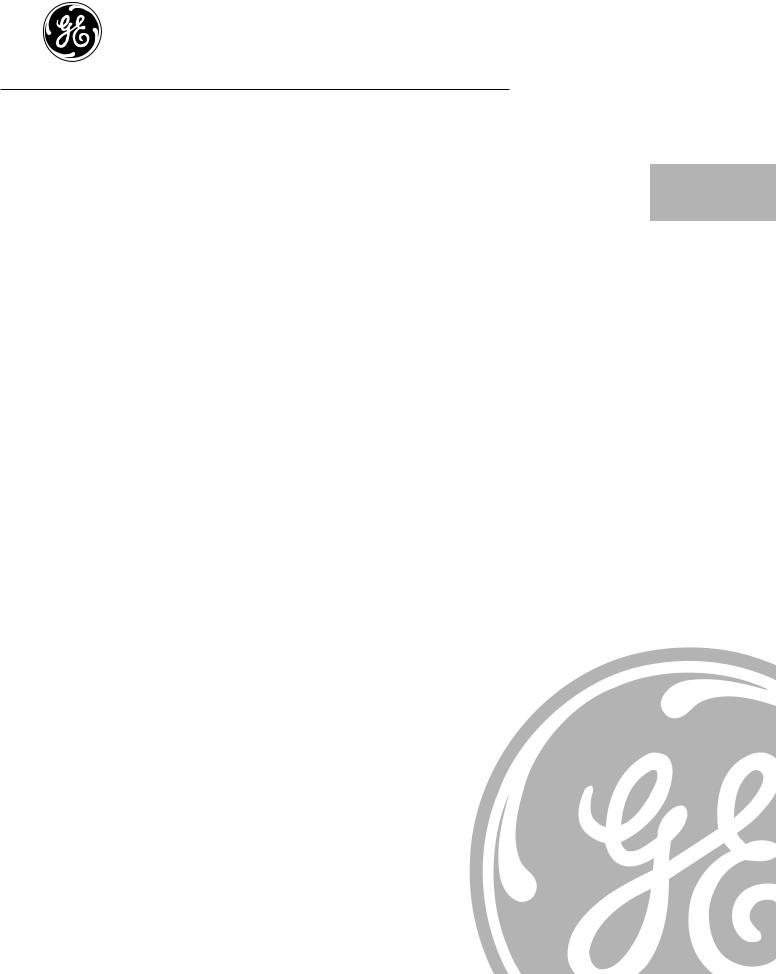
Ranges
Non-Self-Cleaning Gas
www.GEAppliances.com
Safety Instructions . . . . . . .2–7
Operating Instructions
Aluminum Foil . . . . . . . . . . . .15
Burners . . . . . . . . . . . . . . .10, 11
Clock . . . . . . . . . . . . . . . . . . . .13
Features . . . . . . . . . . . . . . . .8, 9
Griddle . . . . . . . . . . . . . . . . . .12
Oven . . . . . . . . . . . . . . . . .13–18
Baking and Roasting . . . . . .15
Broiling . . . . . . . . . . . . . .16, 17
Broiling Guide . . . . . . . . . . .17
Light . . . . . . . . . . . . . . . . . . .14
Oven Control . . . . . . . . . . . .13
Power Outage . . . . . . . . . . . .14
Preheating . . . . . . . . . . . . . .15
Thermostat Adjustment . . . .18
Vent . . . . . . . . . . . . . . . . . . . .14
Care and Cleaning
Broiler Compartment . . . . . .24
Broiler Pan and Grid . . . . . . .23
Burner Assembly . . . . . . .20, 21
Burner Grates . . . . . . . . . . . . .22
Control Panel and Knobs . . .25
Cooktop Surface . . . . . . . . . .22
Door Removal . . . . . . . . . . . .23
Griddle . . . . . . . . . . . . . . . . . .19
Kick Panel . . . . . . . . . . . . . . . .24
Oven Bottom . . . . . . . . . . . . .23
Oven Interior . . . . . . . . . . . . .25
Oven Light Replacement . . .24
Oven Vents . . . . . . . . . . . . . . .25
Shelves . . . . . . . . . . . . . . . . . .24
Write the model and serial numbers here:
Model # ________________________
Serial # ________________________
You can find them on a label on the front of the range behind the kick panel or broiler compartment.
Installation
Instructions . . . . . . . . . . .26–38 Air Adjustment . . . . . . . . . . . .37 Anti-Tip Device . . . . . . . . .30, 38 Assembling
Surface Burners . . . . . . . . . . .35 Checking Burner Ignition . . .36 Connecting the Range
to Gas . . . . . . . . . . . . . . . .31–33 Dimensions and
Clearances . . . . . . . . . . . . . . .29 Electrical Connections . . .34, 35 Leveling the Range . . . . . . . .37 Location . . . . . . . . . . . . . . . . .30 LP . . . . . . . . . . . . . . . . . . . . . .38 Model and Serial Number Location . . . . . . . . . . . . . . . . .30
Troubleshooting Tips . . .39, 40
Consumer Support
Consumer
Support . . . . . . . . . .Back Cover
Product Registration . . . .41, 42
Warranty . . . . . . . . . . . . . . . . .43
Owner’s Manual
& Installation
Instructions
JGBS09
JGBS10
183D5580P132 49-85045 03-03 JR
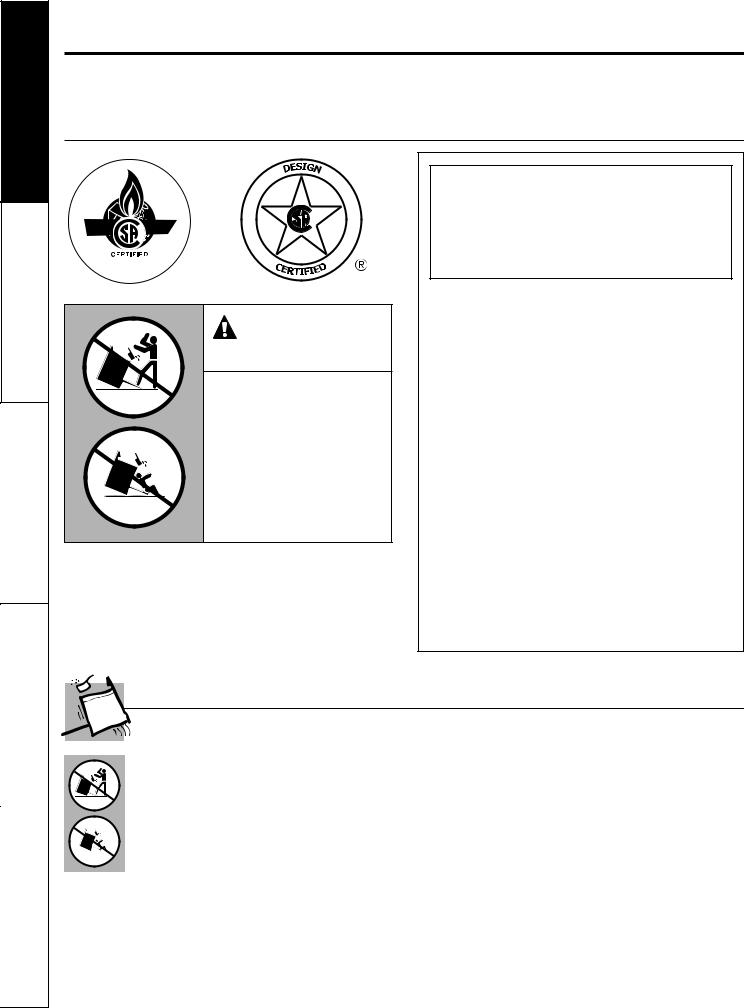
Consumer Support Troubleshooting Tips Installation Instructions Operating Instructions Safety Instructions
IMPORTANT SAFETY INFORMATION.
READ ALL INSTRUCTIONS BEFORE USING.
 WARNING!
WARNING!
For your safety, the information in this manual must be followed to minimize the risk of fire or explosion, electric shock, or to prevent property damage, personal injury, or loss of life.
|
WARNING: If the information |
|
|
in this manual is not followed exactly, |
|
|
a fire or explosion may result causing |
|
|
property damage, personal injury |
|
® |
or death. |
|
|
||
|
— Do not store or use gasoline or other |
|
WARNING! |
flammable vapors and liquids in the |
|
vicinity of this or any other appliance. |
||
ANTI-TIP DEVICE |
— WHAT TO DO IF YOU |
|
■ ALL RANGES CAN TIP |
SMELL GAS |
|
■ INJURY TO PERSONS |
■ Do not try to light any appliance. |
|
COULD RESULT |
■ Do not touch any electrical switch; |
|
■ INSTALL ANTI-TIP |
||
do not use any phone in your |
||
DEVICES PACKED WITH |
building. |
|
RANGE |
■ Immediately call your gas supplier |
|
■ SEE INSTALLATION |
||
from a neighbor’s phone. Follow the |
||
INSTRUCTIONS |
gas supplier’s instructions. |
|
|
||
|
■ If you cannot reach your gas supplier, |
|
|
call the fire department. |
|
|
— Installation and service must be |
|
|
performed by a qualified installer, |
|
|
service agency or the gas supplier. |
ANTI-TIP DEVICE
All ranges can tip and injury could result.
To prevent accidental tipping of the range, attach it to the wall by installing the Anti-Tip device supplied.
If the Anti-Tip device supplied with the range does not fit this application, use the universal Anti-Tip device WB2X7909.
To check if the device is installed and engaged properly, carefully tip the range forward. The Anti-Tip device should engage and prevent the range from tipping over.
If you pull the range out from the wall for any reason, make sure the device is properly engaged when you push the range back against the wall. If it is not, there is a possible risk of the range tipping over and causing injury if you or a child stand, sit or lean on an open door.
Please refer to the Anti-Tip device information in this manual. Failure to take this precaution could result in tipping of the range and injury.
2
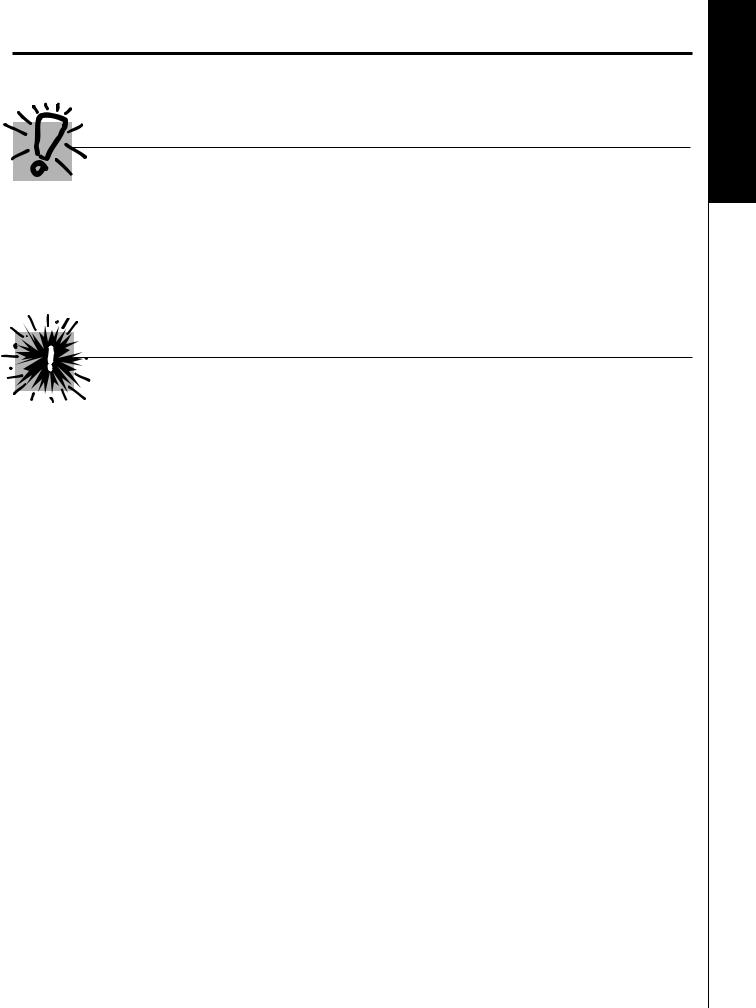
www.GEAppliances.com
 WARNING!
WARNING!
IMPORTANT SAFETY NOTICE
The California Safe Drinking Water and Toxic Enforcement Act requires the Governor of California to publish a list of substances known to the state to cause birth defects or other reproductive harm, and requires businesses to warn customers of potential exposure to such substances.
Gas appliances can cause minor exposure to four of these substances, namely benzene, carbon monoxide, formaldehyde and soot, caused primarily by the incomplete combustion of natural gas or LP fuels. Properly adjusted burners, indicated by a bluish rather than a yellow flame, will minimize incomplete combustion. Exposure to these substances can be minimized by venting with an open window or using a ventilation fan or hood.
 SAFETY PRECAUTIONS
SAFETY PRECAUTIONS
Have the installer show you the location of the range gas shut-off valve and how to shut it off if necessary.
■Have your range installed and properly grounded by a qualified installer, in accordance with the Installation Instructions. Any adjustment and service should be performed only by qualified gas range installers or service technicians.
■Do not attempt to repair or replace any part of your range unless it is specifically recommended in this manual. All other service should be referred to a qualified technician.
■Plug your range into a 120-volt grounded outlet only. Do not remove the round grounding prong from the plug. If in doubt about the grounding of the home electrical system, it is your personal responsibility and obligation to have an ungrounded outlet replaced with a properly grounded, three-prong outlet in accordance with
the National Electrical Code. Do not use an extension cord with this appliance.
3
Support Consumer Tips Troubleshooting Instructions Installation Instructions Operating Instructions Safety
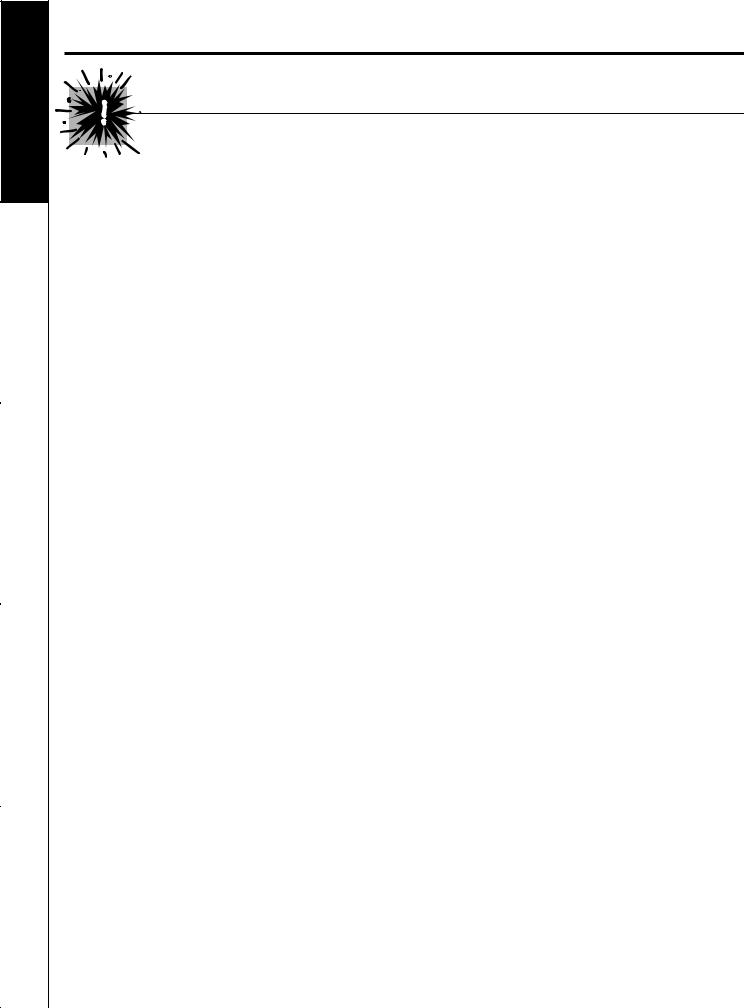
Consumer Support Troubleshooting Tips Installation Instructions Operating Instructions Safety Instructions
IMPORTANT SAFETY INFORMATION. READ ALL INSTRUCTIONS BEFORE USING.
 SAFETY PRECAUTIONS
SAFETY PRECAUTIONS
 ■ Locate the range out of kitchen traffic path and out of drafty locations to prevent poor air circulation.
■ Locate the range out of kitchen traffic path and out of drafty locations to prevent poor air circulation.
■Be sure all packaging materials are removed from the range before operating it to prevent fire or smoke damage should the packaging material ignite.
■Be sure your range is correctly adjusted by a qualified service technician or installer for the type of gas (natural or LP) that is to be used. Your range can be converted for use with either type of gas. See the Installation of the range section.
■WARNING: These adjustments must be made by a qualified service technician in accordance with the manufacturer’s instructions and all codes and requirements of the authority having jurisdiction. Failure to follow these instructions could result in serious injury or property damage. The qualified agency performing this work assumes responsibility for the conversion.
■After prolonged use of a range, high floor temperatures may result and many floor coverings will not withstand this kind of use. Never install the range over vinyl tile or linoleum that cannot withstand such type of use. Never install it directly over interior kitchen carpeting.
■Do not leave children alone or unattended where a range is hot or in operation. They could be seriously burned.
■Do not allow anyone to climb, stand or hang on the oven door, broiler compartment or cooktop. They could damage the range and even tip it over, causing severe personal injury.
■CAUTION: Items of interest to children should not be stored in cabinets above a range or on the backsplash of a range—children climbing on the range to reach items could be seriously injured.
■For your safety, never use your appliance for warming or heating the room.
■Clean only parts listed in this Owner’s Manual.
■Never wear loose fitting or hanging garments while using the appliance. Be careful when reaching for items stored in cabinets over the range. Flammable material could be ignited if brought in contact with flame or hot oven surfaces and may cause severe burns.
■Do not store flammable materials in an oven, a range broiler, behind the kick panel or near a cooktop.
■Do not store or use combustible materials, gasoline or other flammable vapors and liquids in the vicinity of this or any other appliance.
■Do not let cooking grease or other flammable materials accumulate in or near the range.
■Do not use water on grease fires. Never pick up a flaming pan. Turn the controls off. Smother a flaming pan on a surface burner by covering the pan completely with a well-fitting lid, cookie sheet or flat tray.
Use a multi-purpose dry chemical or foam-type fire extinguisher.
■Flaming grease outside a pan can be put out by covering it with baking soda or, if available, by using a multi-purpose dry chemical or foam-type fire extinguisher.
■Flame in the oven can be smothered completely by closing the oven door and turning the control to off or by using a multi-purpose dry chemical or foam-type fire extinguisher.
■Let the burner grates and other surfaces cool before touching them or leaving them where children can reach them.
■Never block the vents (air openings) of the range. They provide the air inlet and outlet that are necessary for the range to operate properly with correct combustion. Air openings are located at the rear of the cooktop, at the top and bottom of the oven door, and at the bottom of the range under the broiler compartment or kick panel.
■Large scratches or impacts to glass doors can lead to broken or shattered glass.
4
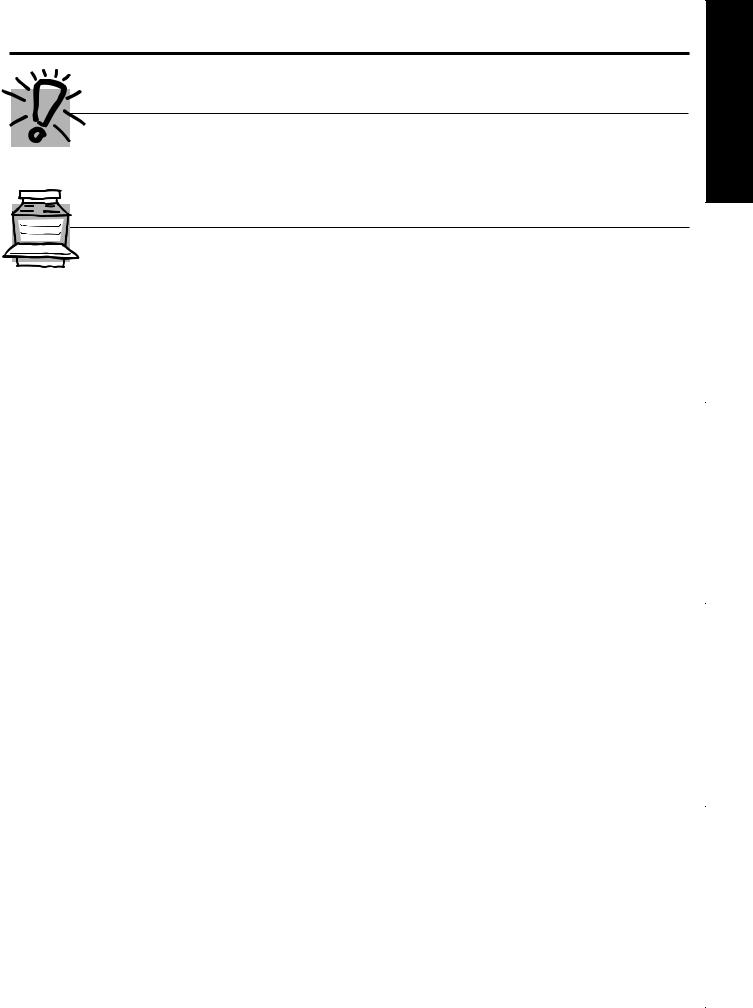
www.GEAppliances.com
COOK MEAT AND POULTRY THOROUGHLY…
Cook meat and poultry thoroughly—meat to at least an INTERNAL temperature of 160°F and poultry to at least an INTERNAL temperature of 180°F. Cooking to these temperatures usually protects against foodborne illness.
OVEN
Stand away from the range when opening the door of a hot oven. The hot air and steam that escape can cause burns to hands, face and eyes.
■Do not use the oven for a storage area. Items stored in the oven can ignite.
■Keep the oven free from grease buildup.
■Place the oven shelves in the desired position while the oven is cool.
■Pulling out the shelf to the stop-lock is a convenience in lifting heavy foods. It is also a precaution against burns from touching hot surfaces of the door or oven walls. The lowest position is not designed to slide.
■Do not heat unopened food containers. Pressure could build up and the container could burst, causing an injury.
■Never use aluminum foil to line the oven bottom. Improper use of foil could start
a fire and result in high carbon monoxide.
■Do not use aluminum foil anywhere in the oven except as described in this manual. Misuse could result in a fire hazard or damage to the range.
■When using cooking or roasting bags in the oven, follow the manufacturer’s directions.
■Do not use your oven to dry newspapers. If overheated, they can catch fire.
■Use only glass cookware that is recommended for use in gas ovens.
■Always remove the broiler pan from range as soon as you finish broiling. Grease left in the pan can catch fire if oven is used without removing the grease from the broiler pan.
■When broiling, if meat is too close to the flame, the fat may ignite. Trim excess fat to prevent excessive flare-ups.
■Make sure the broiler pan is in place correctly to reduce the possibility of grease fires.
■If you should have a grease fire in the broiler pan, turn off the oven control, and keep
the broiler compartment and oven door closed to contain fire until it burns out.
■For safety and proper cooking performance, always bake and broil with the oven door closed.
5
Support Consumer Tips Troubleshooting Instructions Installation Instructions Operating Instructions Safety
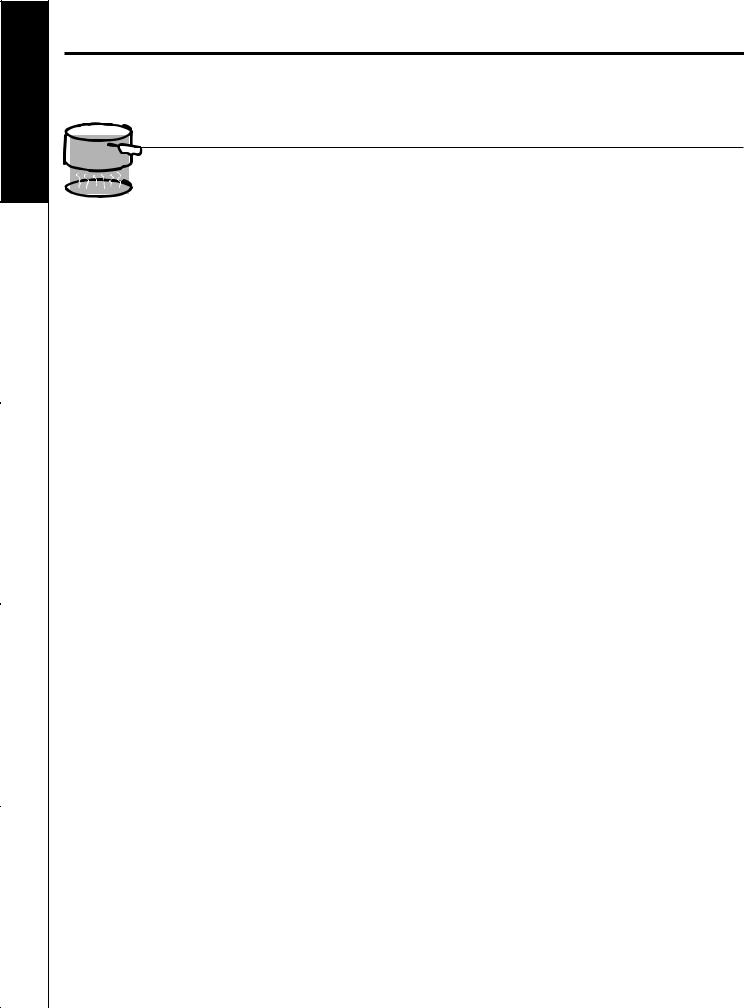
Consumer Support Troubleshooting Tips Installation Instructions Operating Instructions Safety Instructions
IMPORTANT SAFETY INFORMATION.
READ ALL INSTRUCTIONS BEFORE USING.
 WARNING!
WARNING!
SURFACE BURNERS
Use proper pan size—avoid pans that are unstable or easily tipped. Select cookware having flat bottoms large enough to cover burner grates. To avoid spillovers, make sure cookware is large enough to contain the food properly. This will both save cleaning time and prevent hazardous accumulations of food, since heavy spattering or spillovers left on range can ignite. Use pans with handles that can be easily grasped and remain cool.
■Always use the LITE position when igniting the top burners and make sure the burners have ignited.
■Never leave the surface burners unattended at high flame settings. Boilovers cause smoking and greasy spillovers that may catch on fire.
■Adjust the top burner flame size so it does not extend beyond the edge of the cookware. Excessive flame is hazardous.
■Use only dry pot holders—moist or damp pot holders on hot surfaces may result in burns from steam. Do not let pot holders come near open flames when lifting cookware. Do not use a towel or other bulky cloth in place of a pot holder.
■When using glass cookware, make sure it is designed for top-of-range cooking.
■To minimize the possibility of burns, ignition of flammable materials and spillage, turn cookware handles toward the side or back of the range without extending over adjacent burners.
■Carefully watch foods being fried at a high flame setting.
■Always heat fat slowly, and watch as it heats.
■Do not leave any items on the cooktop. The hot air from the vent may ignite flammable items and will increase pressure in closed containers, which may cause them to burst.
■If a combination of oils or fats will be used in frying, stir together before heating or as fats melt slowly.
■Use a deep fat thermometer whenever possible to prevent overheating fat beyond the smoking point.
■Use the least possible amount of fat for effective shallow or deep-fat frying. Filling the pan too full of fat can cause spillovers when food is added.
■When flaming foods are under the hood, turn the fan off. The fan, if operating, may spread the flames.
■Do not use a wok on the cooking surface if the wok has a round metal ring that is placed over the burner grate to support the wok. This ring acts as a heat trap, which may damage the burner grate and burner head. Also, it may cause the burner to work improperly. This may cause a carbon monoxide level above that allowed by current standards, resulting
in a health hazard.
6
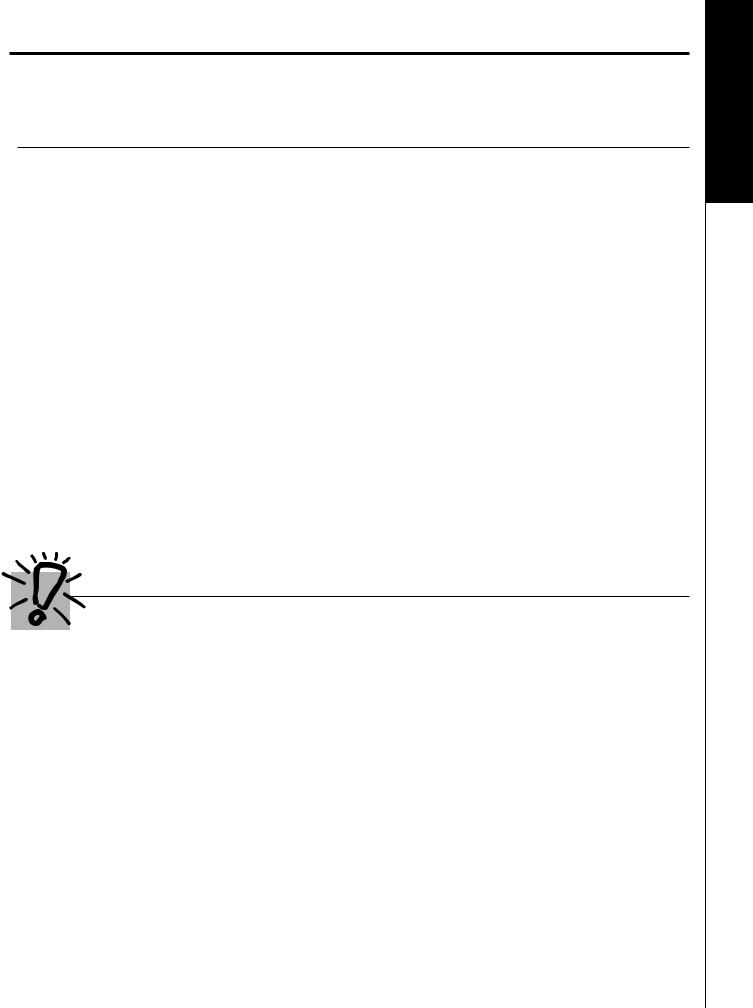
www.GEAppliances.com
■Do not use aluminum foil to line the griddle. Misuse could result in a fire hazard.
■Never leave the kitchen while using the griddle.
■Foods for frying should be as dry as possible. Frost on frozen foods or moisture on fresh foods can cause hot fat to bubble up and over the sides of the pan.
■Never try to move a pan of hot fat, especially a deep fat fryer. Wait until the fat is cool.
■Do not leave plastic items on the cooktop— they may melt if left too close to the vent.
■Keep all plastics away from the surface burners.
■To avoid the possibility of a burn, always be certain that the controls for all burners are at the OFF position and all grates and the griddle are cool before attempting to remove them.
■If range is located near a window, do not hang long curtains that could blow over the surface burners and create a fire hazard.
■If you smell gas, turn off the gas to the range and call a qualified service technician. Never use an open flame to locate a leak.
■Always turn the surface burner controls off before removing cookware or the griddle.
■Do not lift the cooktop. Lifting the cooktop can lead to damage and improper operation of the range.
■Do not place or store items that can melt or catch fire on the grates, even when the cooktop is not being used.
■Keep range clean and free of accumulations of grease or spillovers, which may ignite.
READ AND FOLLOW THIS SAFETY INFORMATION CAREFULLY.
SAVE THESE INSTRUCTIONS
7
Support Consumer Tips Troubleshooting Instructions Installation Instructions Operating Instructions Safety
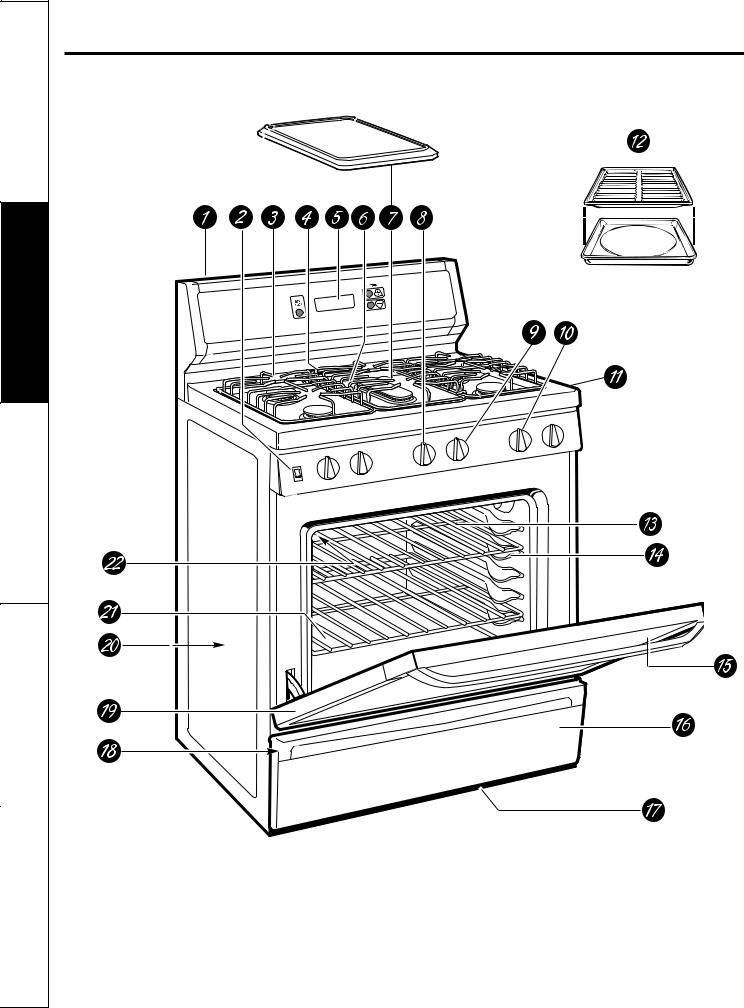
Consumer Support Troubleshooting Tips Installation Instructions Operating Instructions Safety Instructions
Features of your range.
Features and appearance may vary from your model.
8
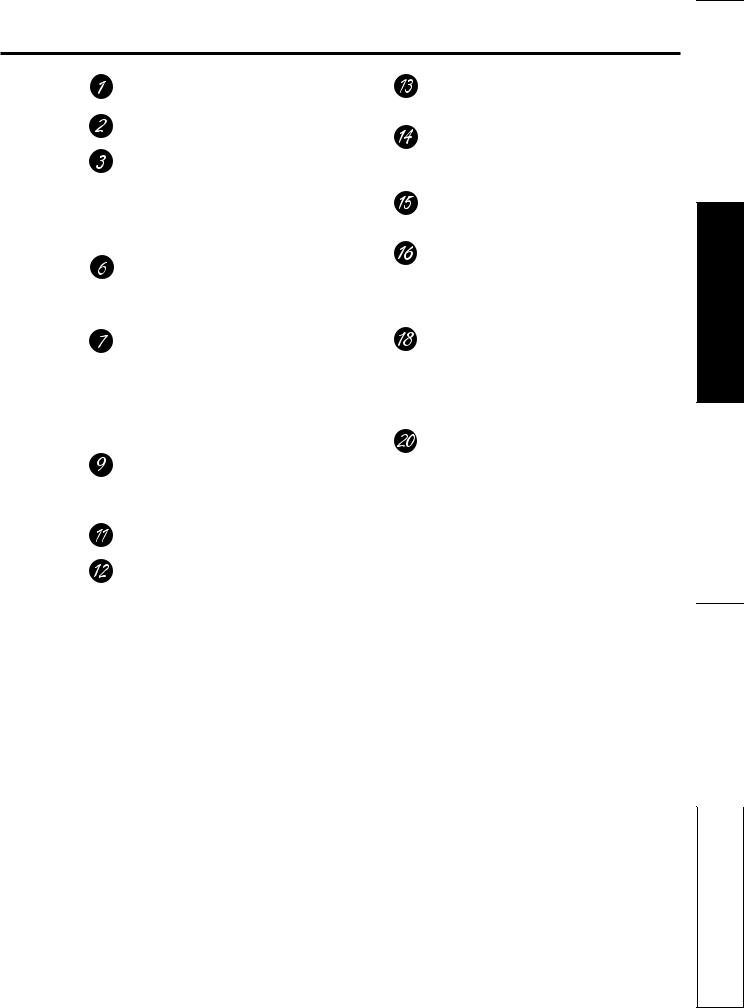
www.GEAppliances.com
Backguard
Oven Light On/Off Switch
Side Surface Burners and Grates
 Oven Vent (located on cooktop)
Oven Vent (located on cooktop)
 CLOCK (on some models)
CLOCK (on some models)
Center Surface Burner
Use when cooking with large oval pots/pans, round pots/pans 10″ or greater in diameter or with the griddle.
Griddle and Center Grate
When cooking, the center grate must always be in place. To use the griddle, it must be locked onto the center grate only.
 Center/Griddle Surface Burner Control Knob
Center/Griddle Surface Burner Control Knob
Oven Control
 Side Surface Burner Control Knobs
Side Surface Burner Control Knobs
Cooktop
Broiler Pan and Grid (on some models)
Oven Shelves with Stop-Locks (number of shelves varies)
Oven Shelf Supports (shelf positions for cooking are suggested in the Using the Oven section)
Air Vent in Oven Door (located at top of oven door)
Broiler Compartment or Removable Kick Panel (on some models)
 Air Intake
Air Intake
Model and Serial Numbers (located on front frame of range, behind either broiler compartment or removable kick panel)
 Lift-Off Oven Door
Lift-Off Oven Door
Anti-Tip Device (lower right rear corner on range back. See Installation Instructions.)
 Oven Bottom
Oven Bottom
 Oven Interior Light
Oven Interior Light
9
Support Consumer Tips Troubleshooting Instructions Installation Instructions Operating Instructions Safety
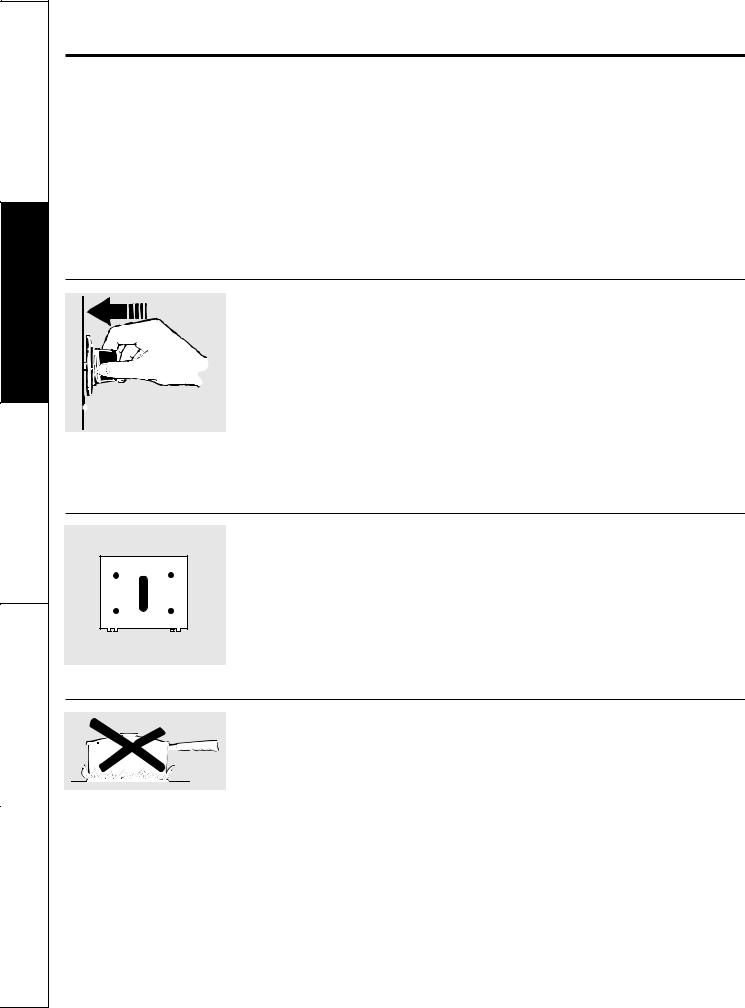
Consumer Support Troubleshooting Tips Installation Instructions Operating Instructions Safety Instructions
Using the gas surface burners.
Throughout this manual, features and appearance may vary from your model.
Before Lighting a Gas Burner
■Make sure all burners are in place.
■Make sure all grates (and the center griddle, if it is going to be used) on the range are properly placed before using any burner.
After Lighting a Gas Burner
■Do not operate the burner for an extended period of time without cookware on the grate. The finish on the grate may chip without cookware to absorb the heat.
■Be sure the burners, griddle and grates are cool before you place your hand, a pot holder, cleaning cloths or other materials on them.
How to Light a Gas Surface Burner
Push the control knob in and turn it to the LITE position.
Make sure all the surface burners are placed in their respective positions.
Push the control knob in and turn it to the LITE position.
You will hear a little clicking noise— the sound of the electric spark igniting the burner.
Turn the knob to adjust the flame size. If the knob stays at LITE, it will continue to click.
When one burner is turned to LITE,
all the burners spark. Do not attempt to disassemble or clean around any burner while another burner is on. An electric shock may result, which could cause you to knock over hot cookware.
Surface Burner Controls
Knobs that turn the surface burners on and off are marked as to which burners they control. The two knobs on the left control the left front and left rear burners. The two knobs on the right control the right front and right rear burners. The center left knob controls the center oval burner.
The center oval burner is the largest in size and is for large oval pots/pans, round pots/pans 10″ or greater in diameter or with the griddle.
The side burners are all the same size and power.
How to Select Flame Size
For safe handling of cookware, never let the flames extend up the sides of the cookware.
Watch the flame, not the knob, as you reduce heat. When fast heating is desired, the flame size on a gas burner should match the cookware you are using.
Flames larger than the bottom of the cookware will not result in faster heating of the cookware and could be hazardous.
Use only large oval pots/pans, round pots/pans 10″ or greater in diameter or the griddle on the center burner.
10
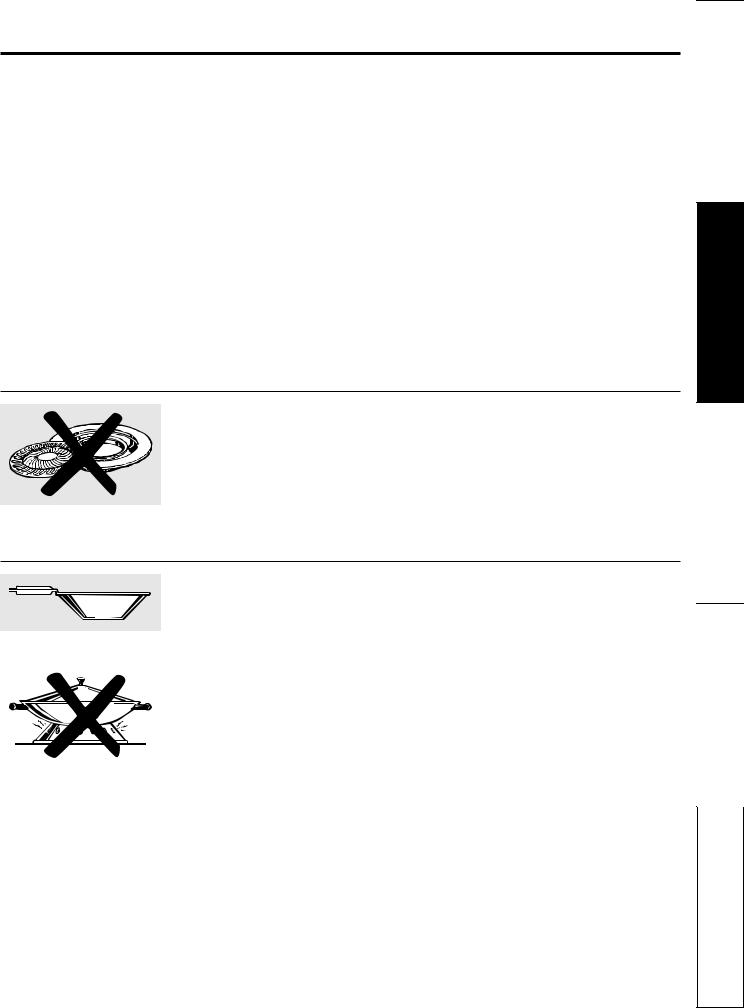
www.GEAppliances.com
Top-of-Range Cookware
Aluminum: Medium-weight cookware is recommended because it heats quickly and evenly. Most foods brown evenly in an aluminum skillet. Use saucepans with tightfitting lids when cooking with minimum amounts of water.
Cast-Iron: If heated slowly, most skillets will give satisfactory results.
Enamelware: Under some conditions, the enamel of some cookware may melt. Follow cookware manufacturer’s recommendations for cooking methods.
Glass: There are two types of glass cookware—those for oven use only and those for top-of-range cooking (saucepans, coffee and teapots). Glass conducts heat very slowly.
Heatproof Glass Ceramic: Can be used for either surface or oven cooking. It conducts heat very slowly and cools very slowly. Check cookware manufacturer’s directions to be sure it can be used on gas ranges.
Stainless Steel: This metal alone has poor heating properties and is usually combined with copper, aluminum or other metals for improved heat distribution. Combination metal skillets usually work satisfactorily if they are used with medium heat as the manufacturer recommends.
Stove Top Grills
Do not use stove top grills on your sealed gas burners. If you use the stove top grill on the sealed gas burner, it will cause incomplete combustion and can result in exposure to carbon monoxide levels above allowable standards.
This can be hazardous to your health.
Wok This Way
|
We recommend that you use a 14 ″ or smaller |
Do not use a flat-bottomed wok on a |
|
|
flat-bottomed wok. Make sure the wok bottom |
support ring. Placing the ring over the |
|
Use a flat-bottomed wok. |
sits flat on the grate. They are available at your |
burner or grate may cause the burner |
|
local retail store. |
to work improperly, resulting in carbon |
||
|
|
Only a flat-bottomed wok should be used. |
monoxide levels above allowable standards. |
|
||
|
This could be dangerous to your health. |
|
|
|
|
|
|
|
|
|
|
In Case of Power Failure
In case of a power failure, you can light the gas surface burners on your range with a match. Hold a lit match to the burner, then push in and turn the control knob to the LITE position. Use extreme caution when lighting burners this way.
Surface burners in use when an electrical power failure occurs will continue to operate normally.
11
Support Consumer Tips Troubleshooting Instructions Installation Instructions Operating Instructions Safety

Consumer Support Troubleshooting Tips Installation Instructions Operating Instructions Safety Instructions
Using the griddle.
|
Your non-stick coated griddle provides |
NOTE: Your griddle will discolor over time as it |
|
||
|
an extra-large cooking surface for meats, |
becomes seasoned with use. |
|
pancakes, or other food usually prepared |
|
|
in a frying pan or skillet. |
|
|
|
|
|
|
|
Underside of griddle
“U” locks
How to Insert the Griddle
 CAUTION: Place and remove the griddle only when all grates and griddle are cool and all surface units are turned OFF.
CAUTION: Place and remove the griddle only when all grates and griddle are cool and all surface units are turned OFF.
The griddle can only be used with the center burner and must be locked into place on the center grate.
Place the “U” locks on the underside of the griddle over the center fingers of the center grate.
Move the griddle back-and-forth to make sure it is locked in place.
Place the “U” locks onto the center fingers on the center grate.
Using the Griddle
Most griddled foods require cooking on a preheated surface. Preheat griddle
according to the guide below, then switch to the desired cook setting.
Type of Food |
Preheat |
Maximum Quantity |
|
Conditions |
Recommended |
Warming |
none |
7 stacked |
Tortillas |
|
|
Pancakes |
High for |
6 |
|
3 minutes |
|
Hamburgers |
Medium for |
4 – flattened out |
|
5 minutes |
|
Fried Eggs |
Medium for |
4 |
|
5 minutes |
|
Bacon |
High for |
4 |
|
5 minutes |
|
Breakfast |
None–no oil |
13 |
Sausage Links |
|
|
Hot Sandwiches |
High for 6 |
4 |
(such as |
minutes then |
|
Grilled Cheese) |
Medium for |
|
|
4 minutes |
|
|
|
|
IMPORTANT NOTES:
■Avoid cooking extremely greasy foods and be careful of grease spill-over while cooking.
■Do not use oil on the griddle for extended lengths of time. Permanent staining and/or craze lines on the surface could result.
■Do not cook milk products (such as french toast) on the griddle. Permanent staining and/or craze lines on the surface could result.
■Never place or store any items on the griddle, even when it is not in use. The griddle can become heated when using the surrounding burners.
■Do not overheat the griddle. Leaving the griddle burner on at HI for an extended amount of time without food can damage the non-stick coating.
12
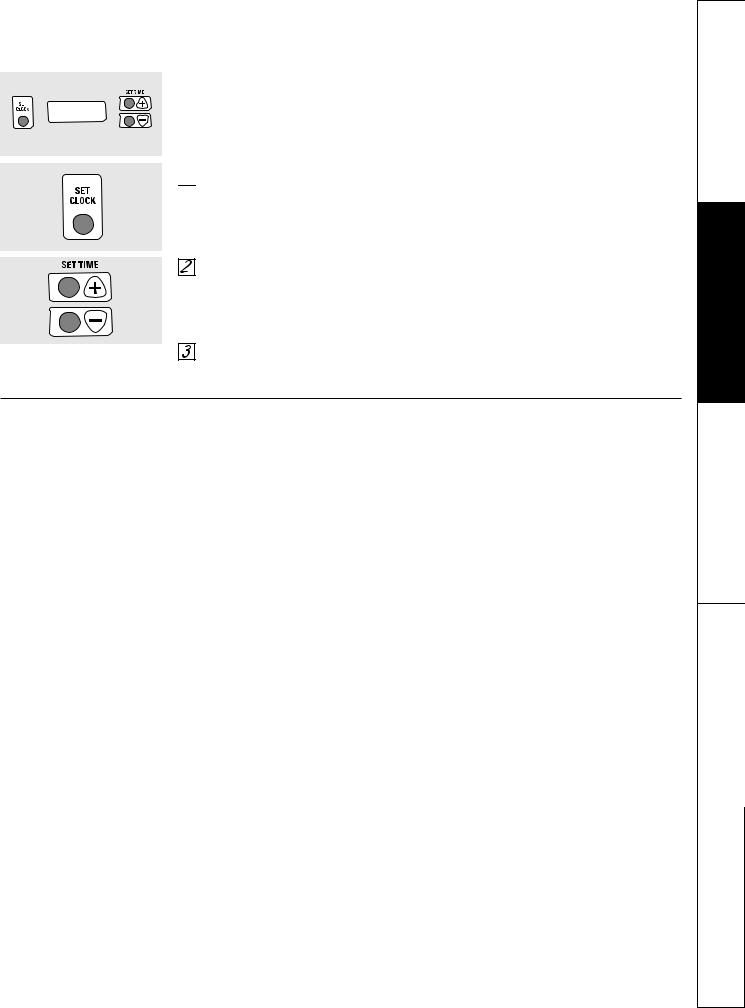
Using the oven. |
www.GEAppliances.com |
To Set the Clock (on some models)
NOTE: When you first plug in the range or after a power failure, the entire Clock display will light up.


 Press the SET CLOCK pad.
Press the SET CLOCK pad.
Press and hold the + or – pad and the time of day will change
10 minutes at a time. To change the time by single minutes, give the pads short taps.
Press the SET CLOCK pad to start the clock.
Oven Control
Your oven is controlled by a single OVEN
CONTROL knob.
It will normally take 30–90 seconds before the flame comes on. After the oven reaches the selected temperature, the oven burner cycles—off completely, then on with a full flame—to maintain the selected temperature.
13
Support Consumer Tips Troubleshooting Instructions Installation Instructions Operating Instructions Safety

Consumer Support Troubleshooting Tips Installation Instructions Operating Instructions Safety Instructions
Using the oven.
To avoid possible burns, place the shelves in the desired position before you turn the oven on.
The oven has 5 shelf positions.
It also has a special low shelf position (R) for extra large items, such as a large turkey.
Before you begin…
The shelves have stop-locks, so that when placed correctly on the shelf supports (A through E), they will stop before coming completely out, and will not tilt.
When placing and removing cookware, pull the shelf out to the bump on the shelf support.
To remove a shelf, pull it toward you, tilt the front end up and pull it out.
To replace, place the end of the shelf (stop-locks) on the support, tilt up the front and push the shelf in.
NOTE: The shelf is not designed to slide out at the special low shelf (R) position.
Plastic items on the cooktop may melt if left too close to the vent.
Vent appearance and location vary.
Oven Vent
Your oven is vented through ducts at the rear of the range. Do not block these ducts when cooking in the oven—it is important that the flow of hot air from the oven
and fresh air to the oven burner be uninterrupted. Avoid touching the vent openings or nearby surfaces during oven or broiler operation—they may become hot.
■Handles of pots and pans on the cooktop may become hot if left too close to the vent.
■Do not leave plastic or flammable items on the cooktop—they may melt or ignite if left too close to the vent.
■Do not leave closed containers on the cooktop. The pressure in closed containers may increase, which may cause them to burst.
■Metal items will become very hot if they are left on the cooktop, and could cause burns.
Power Outage
 CAUTION: Do not make any attempt to operate the electric ignition oven during an electrical power failure.
CAUTION: Do not make any attempt to operate the electric ignition oven during an electrical power failure.
The oven or broiler cannot be lit during a power failure. Gas will not flow unless the glow bar is hot.
If the oven is in use when a power failure occurs, the oven burner shuts off and cannot be re-lit until power is restored. This is because the flow of gas is automatically stopped and will not resume when power is restored until the glow bar has reached operating temperature.
Oven Light
Use the switch on the lower control panel to turn the light on or off.
14
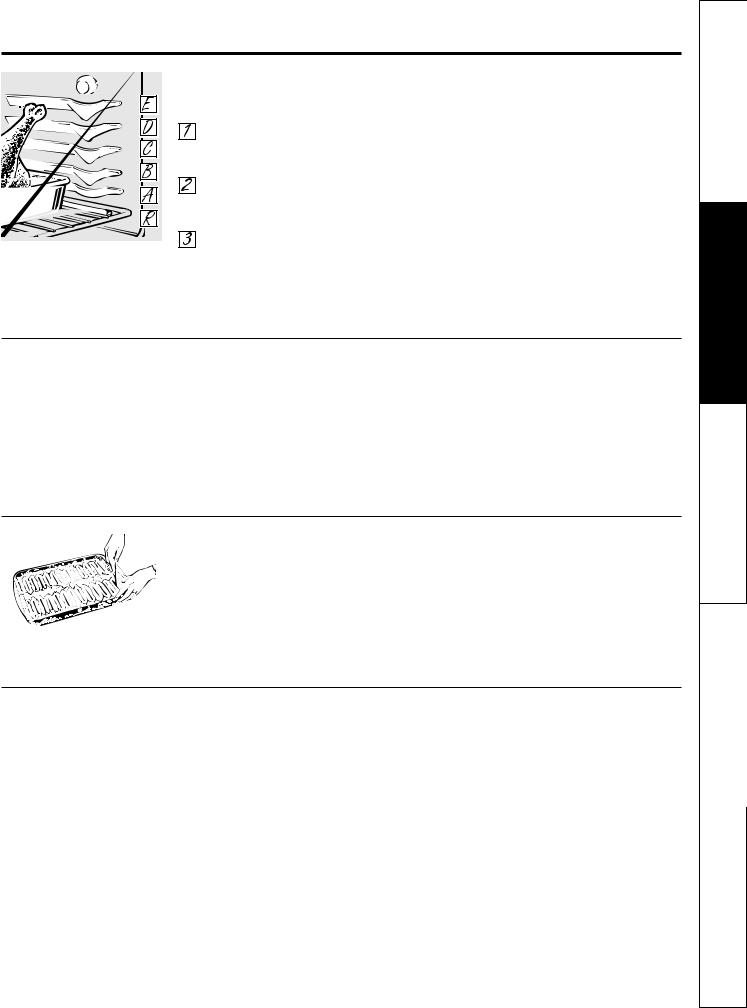
www.GEAppliances.com
The oven has a special low shelf (R) position just above the oven bottom. Use it when extra cooking space is needed, for example, when cooking a large turkey. The shelf is not designed to slide out at this position.
How to Set the Oven for Baking or Roasting
Your oven is not designed for open-door cooking.
Close the oven door. Turn the OVEN CONTROL knob to the desired temperature.
Check food for doneness at minimum time on recipe. Cook longer if necessary.
Turn the OVEN CONTROL knob to OFF when baking is finished and then remove the food from the oven.
Type of Food |
Shelf Position |
Frozen pies (on cookie sheet) |
B or C |
|
|
Angel food cake, |
B |
bundt or pound cakes |
|
|
|
Biscuits, muffins, brownies, |
C |
cookies, cupcakes, |
|
layer cakes, pies |
|
|
|
Casseroles |
B or C |
|
|
Roasting |
R or A |
|
|
Preheating and Pan Placement
Preheat the oven if the recipe calls for it. To preheat, set the oven at the correct temperature. Preheating is necessary for good results when baking cakes, cookies, pastry and breads.
For ovens without a preheat indicator light or tone, preheat 10 minutes.
Baking results will be better if baking pans are centered in the oven as much as possible. Pans should not touch each other or the walls of the oven. If you need
to use two shelves, stagger the pans so one is not directly above the other, and leave approximately 11⁄2″ between pans, from the front, back and sides of the wall.
|
Aluminum Foil |
|
|
Never cover the oven bottom with |
|
|
aluminum foil. |
|
|
You can use aluminum foil to line the |
|
|
broiler pan and broiler grid. However, |
|
|
you must mold the foil tightly to the |
|
Cut slits in the foil just like the grid. |
||
grid and cut slits in it just like the grid. |
Aluminum foil may also be used to catch a spillover. To do so, place a small sheet of foil on a lower shelf several inches below the food.
Never entirely cover a shelf with aluminum foil. This will disturb the heat circulation and result in poor baking.
Oven Moisture
As your oven heats up, the temperature change of the air in the oven may cause water droplets to form on the door glass. These droplets are harmless and will evaporate as the oven continues to heat up.
15
Support Consumer Tips Troubleshooting Instructions Installation Instructions Operating Instructions Safety

Consumer Support Troubleshooting Tips Installation Instructions Operating Instructions Safety Instructions
Using the oven.
Broiling (on some models)
Broiling is cooking food by direct heat from above the food. Most fish and tender cuts of meat can be broiled. Follow these directions to keep spattering and smoking to a minimum.
Your range has a compartment below the oven for broiling.
Both the oven and broiler compartment doors must be CLOSED during broiling.
Turn most foods once during cooking (the exception is thin fillets of fish; oil one side, place that side down on broiler grid and cook without turning until done). Time foods for about one-half the total cooking time, turn food, then continue to cook to preferred doneness.
You can change the distance of the food from the heat source by
positioning the broiler pan and grid on one of three shelf positions in the broiler compartment—A (bottom of broiler compartment), B (middle) and C (top).
Preheating the broiler or oven is not necessary and can produce poor results.
If meat has fat or gristle around the edge, cut vertical slashes through both about 2″ apart. If desired, the fat may be trimmed, leaving a layer about 1/8″ thick.
Arrange the food on the grid and position the broiler pan on the appropriate shelf in the oven or broiling compartment. Placing food closer to the flame increases exterior browning of the food, but also increases spattering and the possibility of fats and meat juices igniting.
Close the oven and broiler compartment door.
Turn the OVEN CONTROL knob to
BROIL.
Turn the OVEN CONTROL knob to OFF. Remove the broiler pan from the broiler compartment and serve the food immediately. Leave the pan outside the range to cool.
Using Aluminum Foil
You can use aluminum foil to line your broiler pan and broiler grid. However, you must mold the foil tightly to the grid and cut slits in it just like the grid.
16
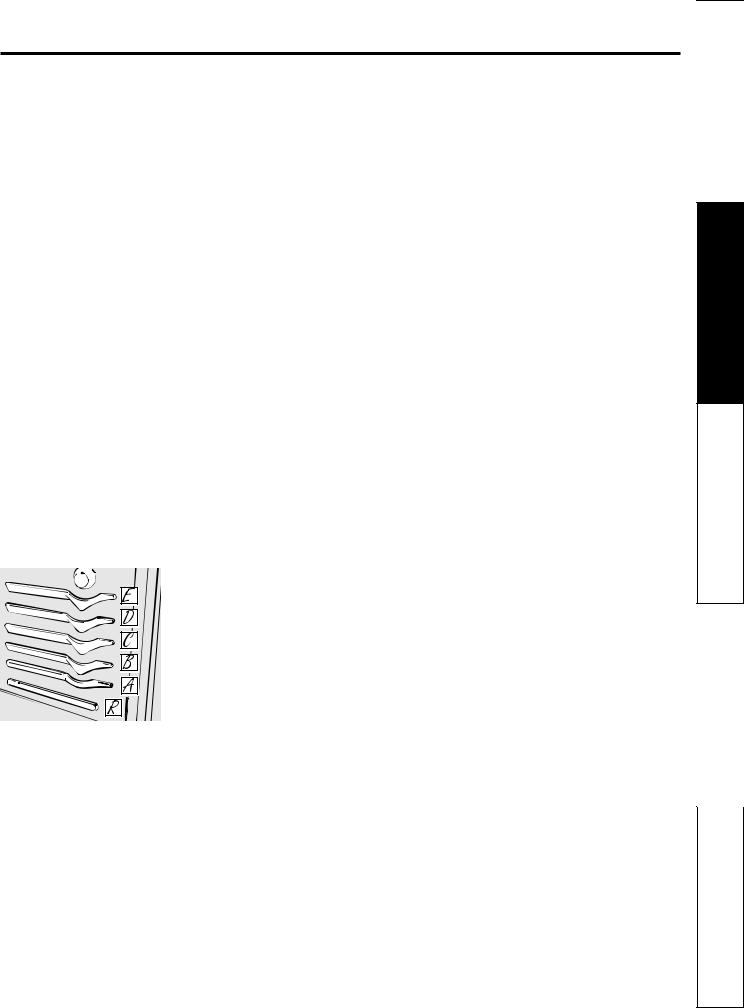
www.GEAppliances.com
Broiling Guide
The size, weight, thickness, starting temperature and your preference of doneness will affect broiling times. This guide is based on meats at refrigerator temperature.
†The U.S. Department of Agriculture says “Rare beef is popular, but you should know that cooking it to only 140°F means some food poisoning organisms may survive.” (Source: Safe Food Book, Your Kitchen Guide, USDA Rev. June 1985.)
The oven has 5 shelf positions.
The oven and broiler compartment doors must be closed during broiling.
■Always use the broiler pan and grid that comes with your range. It is designed to minimize smoking and spattering by trapping juices in the shielded lower part of the pan.
■For steaks and chops, slash fat evenly around the outside edges of the meat. To slash, cut crosswise through the outer fat surface just to the edge of the meat. Use tongs to turn the meat over to prevent piercing the meat and losing juices.
■If desired, marinate meats or chicken before broiling. Or brush with barbecue sauce last 5 to 10 minutes only.
■When arranging the food on the pan, do not let fatty edges hang over the sides because dripping fat could soil the oven.
■The broiler compartment does not need to be preheated. However, for very thin foods, or to increase browning, preheat if desired.
■Frozen steaks can be broiled by positioning the shelf at the next lowest shelf position and increasing the cooking time given in this guide 11⁄2 times per side.
|
Quantity and/ |
Shelf* |
First Side |
Second Side |
|
Food |
or Thickness |
Position |
Time (min.) |
Time (min.) |
Comments |
|
|
|
|
|
|
Bacon |
1/2 lb. |
C |
4 |
3 |
Arrange in single layer. |
|
(about 8 thin slices) |
|
|
|
|
Ground Beef |
1 lb. (4 patties) |
C |
10 |
7–10 |
Space evenly. Up to |
Well Done |
1/2 to 3/4″ thick |
|
|
|
8 patties take about |
|
|
|
|
|
the same time. |
Beef Steaks |
1″ thick |
|
|
|
Steaks less than 1″ thick cook |
Rare† |
C |
9 |
7 |
||
Medium |
(1 to 11⁄2 lbs.) |
C |
12 |
5–6 |
through before browning. |
Well Done |
|
B |
13 |
8–9 |
Pan frying is recommended. |
|
|
|
|
|
Slash fat. |
Rare† |
11⁄2″ thick |
C |
10 |
6–7 |
|
Medium |
(2 to 21⁄2 lbs.) |
C |
12–15 |
10–12 |
|
Well Done |
|
B |
25 |
16–18 |
|
Chicken |
1 whole |
B |
30–35 |
15 |
Brush each side with melted |
|
2 to 21⁄2 lbs., |
|
|
|
butter. Broil skin-side-down |
|
split lengthwise |
|
|
|
first. |
|
4 bone-in breasts |
B |
25–30 |
10–15 |
|
Bakery Products |
|
|
|
|
|
Bread (Toast) or |
2–4 slices |
C |
2–3 |
1/2–1 |
Space evenly. Place English |
Toaster Pastries |
1 pkg. (2) |
|
|
|
muffins cut-side-up and |
English Muffins |
2 split |
C |
3–5 |
|
brush with butter, if desired. |
Lobster Tails |
2–4 |
A |
13–16 |
Do not |
Cut through back of shell. |
|
6 to 8 oz. each |
|
|
turn |
Spread open. Brush with |
|
|
|
|
over. |
melted butter before broiling |
|
|
|
|
|
and after half of broiling |
|
|
|
|
|
time. |
Fish |
1 lb. fillets |
C |
5 |
5 |
Handle and turn very |
|
1/4 to 1/2″ thick |
|
|
|
carefully. Brush with lemon |
|
|
|
|
|
butter before and during |
|
|
|
|
|
cooking, if desired. Preheat |
|
|
|
|
|
broiler to increase browning. |
Ham Slices |
1″ thick |
B |
8 |
8 |
|
(precooked) |
1/2″ thick |
B |
6 |
6 |
|
Pork Chops |
2 (1/2″ thick) |
B |
10 |
4–5 |
Slash fat. |
Well Done |
2 (1″ thick) about 1 lb. |
B |
13 |
9–12 |
|
Lamb Chops |
2 (1″ thick) about 10 |
|
|
|
|
Medium |
B |
8 |
4–7 |
Slash fat. |
|
Well Done |
to 12 oz. |
B |
10 |
10 |
|
Medium |
2 (11⁄2″ thick) about 1 lb. |
B |
10 |
4–6 |
|
Well Done |
|
B |
17 |
12–14 |
|
Wieners |
|
|
|
|
|
Similar Precooked |
1 lb. pkg. (10) |
C |
6 |
1–2 |
If desired, split sausages in |
Sausages, |
|
|
|
|
half lengthwise; cut into 5- to |
Bratwurst |
|
|
|
|
6-inch pieces. |
*See illustration for description of shelf positions.
17
Support Consumer Tips Troubleshooting Instructions Installation Instructions Operating Instructions Safety
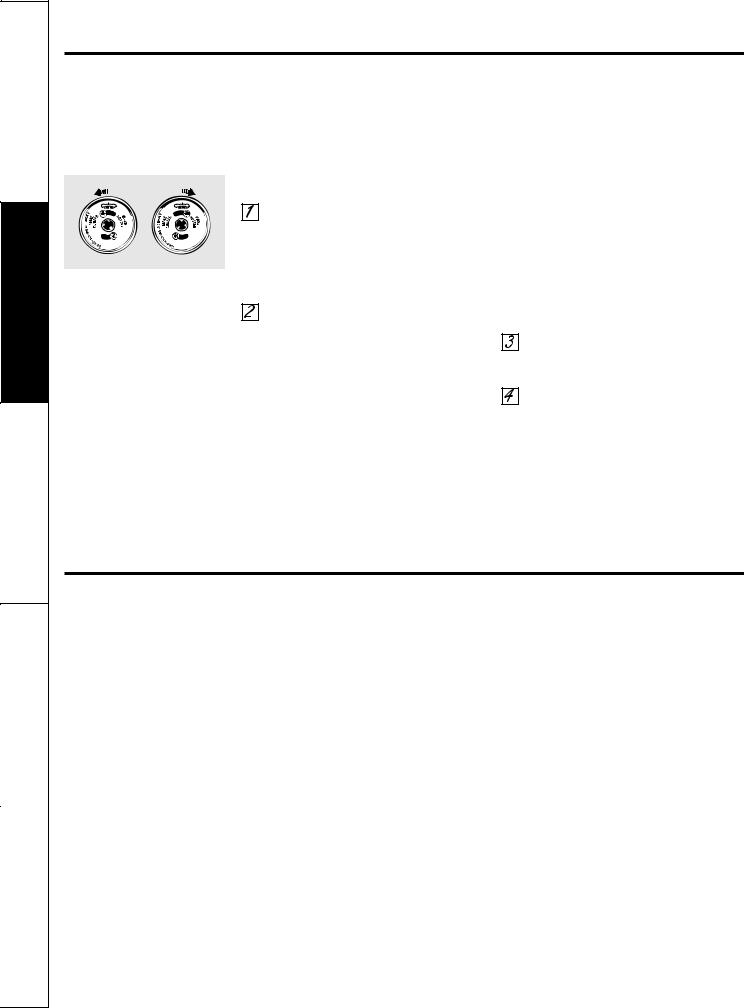
Consumer Support Troubleshooting Tips Installation Instructions Operating Instructions Safety Instructions
Adjust the oven thermostat—Do it yourself!
You may find that your new oven cooks differently than the one it replaced. Use your new oven for a few weeks to become more familiar with it. If you still think your new oven is too hot or too cold, you can adjust the thermostat yourself.
Do not use thermometers, such as those found in grocery stores, to check the temperature setting of your oven. These thermometers may vary 20–40 degrees.
NOTE: This adjustment will not affect the broiling temperature.
To Adjust the Thermostat
|
Pull the OVEN CONTROL knob off the |
|
|
range and look at the back side. |
|
|
To make an adjustment, loosen |
|
|
(approximately one turn), but do not |
|
Appearance may vary. |
completely remove, the two screws on |
|
the back of the knob. |
||
|
||
|
With the back of the knob facing you, |
|
|
hold the outer edge of the knob with |
|
|
one hand and turn the front of the |
|
|
knob with the other hand. |
|
|
To raise the oven temperature, move the |
|
|
top screw toward the right. You’ll hear |
|
|
a click for each notch you move the |
|
|
knob. |
|
|
To lower the temperature, move the top |
|
|
screw toward the left. |
Each click will change the oven temperature approximately 10°F. (Range is plus or minus 60°F from the arrow.) We suggest that you make the adjustment one click from the original setting and check oven performance before making any additional adjustments.
After the adjustment is made, retighten screws so they are snug, but be careful not to overtighten.
Re-install knob on range and check performance.
The type of margarine will affect baking performance!
Most recipes for baking have been developed using high-fat products such as butter or margarine (80% fat). If you decrease the fat, the recipe may not give the same results as with a higher-fat product.
Recipe failure can result if cakes, pies, pastries, cookies or candies are made with low-fat spreads. The lower the fat content of a spread product, the more noticeable these differences become.
Federal standards require products labeled “margarine” to contain at least 80% fat by weight. Low-fat spreads, on the other hand, contain less fat and more water. The high moisture content of these spreads affects the texture and flavor of baked goods. For best results with your old favorite recipes, use margarine, butter or stick spreads containing at least 70% vegetable oil.
18
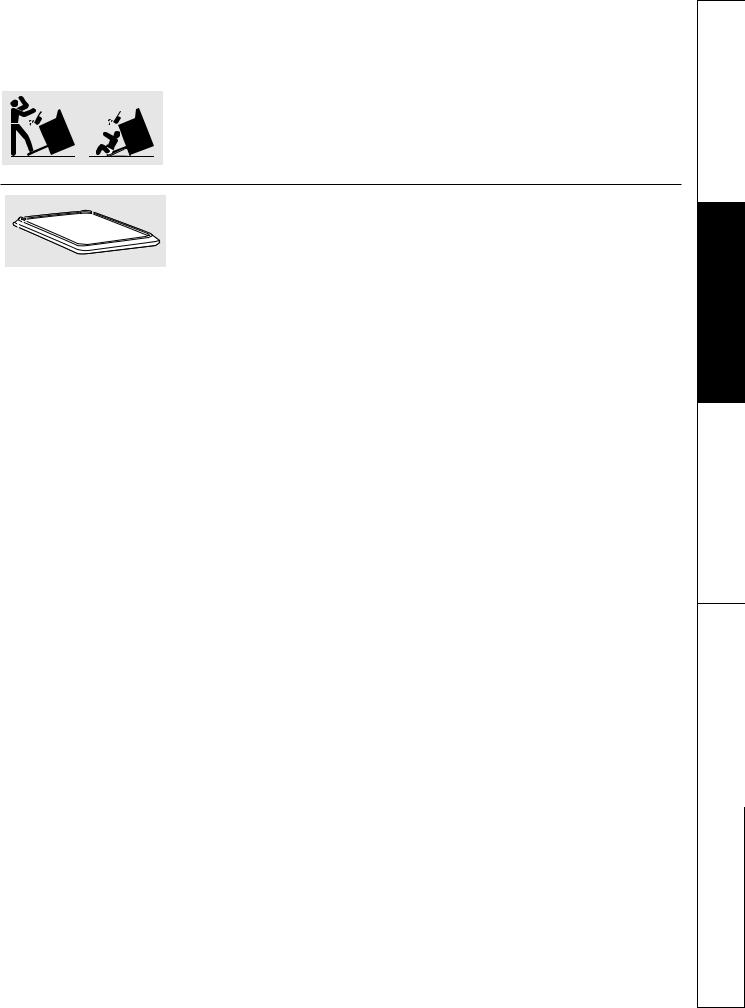
Care and cleaning of the range. |
www.GEAppliances.com |
Be sure electrical power is off and all surfaces are cool before cleaning any part of the range.
If your range is removed for cleaning, servicing or any reason, be sure the anti-tip device is re-engaged properly when the range is replaced. Failure to take this precaution could result in tipping of the range and cause injury.
Griddle
NOTES:
■The griddle is to be used on the center burner grate only.
■Do not clean the griddle in a dishwasher.
Thoroughly clean the griddle of grease and food particles, using a square-edged spatula, while it is still hot.
Wipe the griddle with a dry, heavy, coarse cloth to remove any remaining residue and food particles.
Wash with hot soapy water, rinse and dry.
Once the griddle has cooled, rub the surface lightly with vegetable oil. Do not use corn oil or cooking sprays as they get sticky.
If the griddle is cleaned with anything other than a dry, heavy, coarse cloth, it will need to be reseasoned.
Never flood the hot griddle with cold water. This could cause the griddle to crack or warp.
As the griddle is used and seasoned, it may change color over time.
Griddle Precautions:
■If something has spilled under the griddle, it should be cleaned up as soon as possible to prevent “baked on” food soil.
■Do not allow grease to accumulate under the griddle as it can be a fire hazard. Clean under the griddle as soon as it is cool. Clean with hot soapy water.
19
Support Consumer Tips Troubleshooting Instructions Installation Instructions Operating Instructions Safety
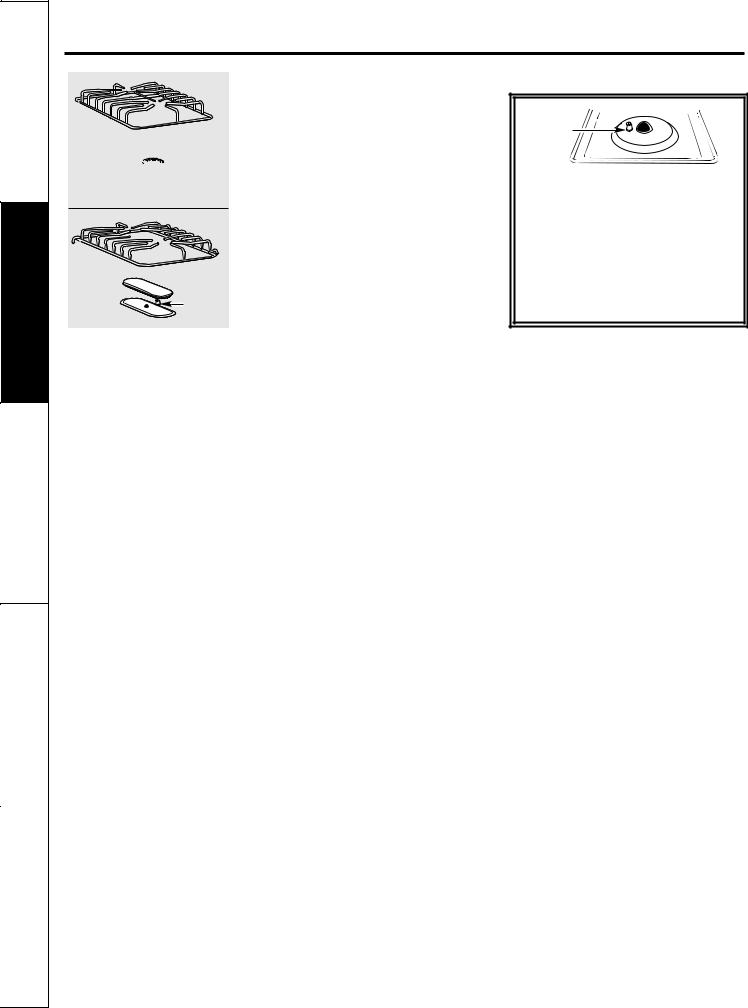
Consumer Support Troubleshooting Tips Installation Instructions Operating Instructions Safety Instructions
Care and cleaning of the range.
Side
Grate
Burner cap 
Burner head 
Electrode

Center
Grate
Burner head |
|
|
and cap |
Electrode |
|
assembly |
||
|
Burner Assemblies
Turn all controls OFF before removing the burner parts.
The burner grates, caps, burner heads and griddle can be lifted off, making them easy to clean. The electrodes are not removable.
 CAUTION: Do not operate the cooktop without all burner parts and grates in place.
CAUTION: Do not operate the cooktop without all burner parts and grates in place.
Electrode
The electrode of the spark igniter is exposed when the burner head is removed. When one burner is turned to LITE, all the burners spark. Do not attempt to disassemble or clean around any burner while another burner is on. An electric shock may result, which could cause you to knock over hot cookware.
20
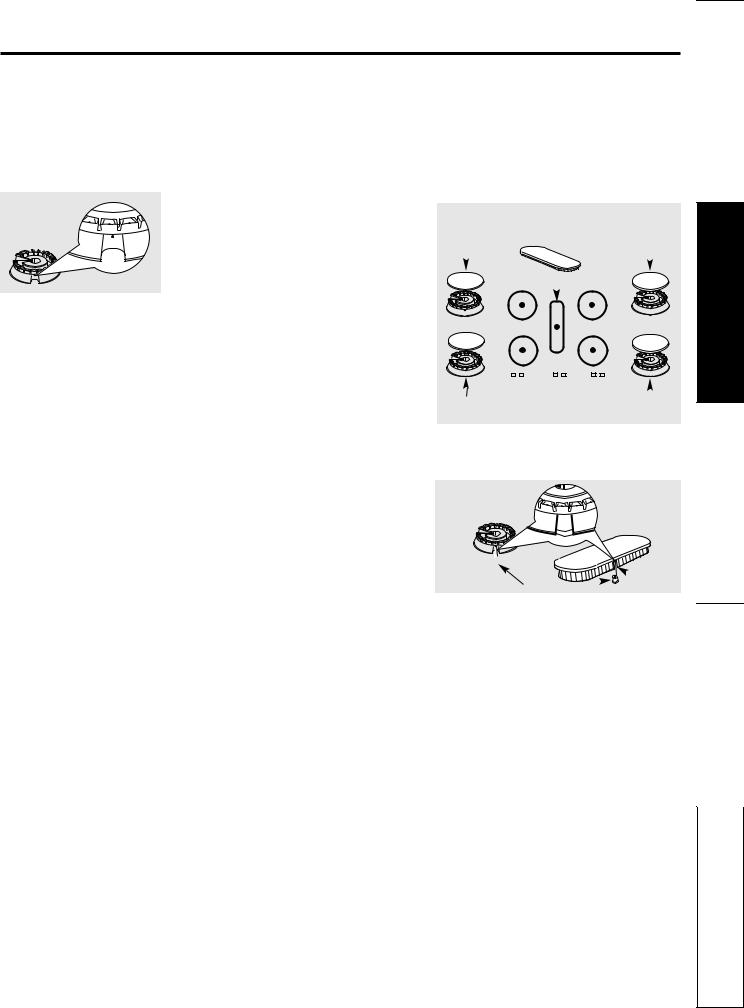
www.GEAppliances.com
Use a sewing needle or twist-tie to unclog the small hole in the burner head.
Burner Caps and Heads
Burner caps
Lift off when cool. Wash burner caps in hot, soapy water and rinse with clean
water. You may scour with a plastic scouring pad to remove burned-on food particles.
Burner heads
For proper ignition, make sure the small hole in the section that fits over the electrode is kept open. A sewing needle or wire twist-tie works well to unclog it.
The slits in the burner heads must be kept clean at all times for an even, unhampered flame.
Clogged or dirty burner ports or electrodes will not allow the burner to operate properly.
Any spill on or around an electrode must be carefully cleaned. Take care to not hit an electrode with anything hard or it could
be damaged.
You should clean the burner caps and burner heads routinely, especially after bad spillovers, which could clog the openings in the burner heads. Lift off when cool.
To remove burned-on food, soak the burner heads in a solution of mild liquid detergent and hot water for 20–30 minutes. For more stubborn stains, use a toothbrush.
NOTE: Do not use steel wool or scouring powders to clean the burners.
After cleaning
Before putting the burner caps and heads back, shake out excess water and then dry them thoroughly by setting in a warm oven for 30 minutes.
Replacement
Replace the burner heads and caps. Make sure that the heads and caps are replaced in the correct location. There is one oval (center) head and cap assembly and four medium (side) heads and caps.
Medium burner |
Oval head and cap |
Medium burner |
|||
head and cap |
head and cap |
||||
|
|
assembly |
|
|
|
|
|
|
|
||
|
|
|
|
|
|
|
|
|
|
|
|
|
|
|
|
|
|
|
|
|
|
|
|
|
|
|
|
|
|
Medium burner |
Front of range |
|
|
|
|||
Medium |
|
burner |
|
head and cap |
head and cap |
||
Make sure the slot in the burner head is positioned over the electrode.

 Slot
Slot
 Slot
Slot
Electrode 
21
Support Consumer Tips Troubleshooting Instructions Installation Instructions Operating Instructions Safety
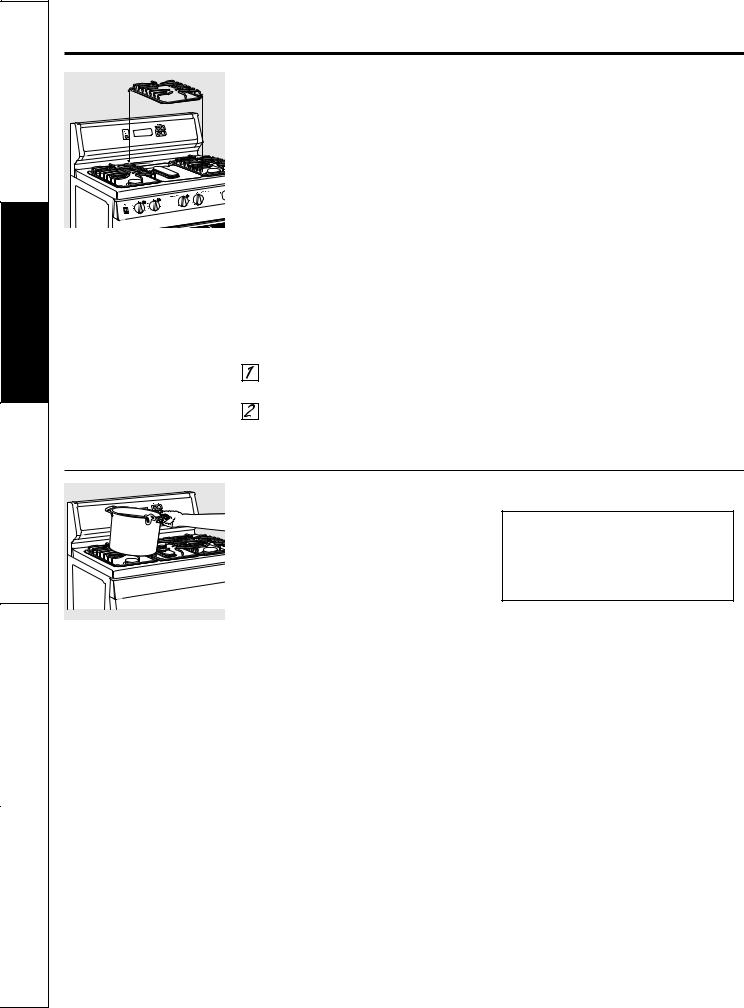
Consumer Support Troubleshooting Tips Installation Instructions Operating Instructions Safety Instructions
Care and cleaning of the range.
Burner Grates
Lift out when cool. First remove the center grate and then the side grates. Grates should be washed regularly and, of course, after spillovers. Wash them in hot, soapy water and rinse with clean water. After cleaning, dry them thoroughly by putting them in a warm oven for a few minutes. Don’t put the grates back on the range while they are wet. When replacing the grates, be sure they are positioned securely over the burners.
Do not operate a burner for an extended period of time without cookware on the grate. The finish on the grate may chip without cookware to absorb the heat.
To replace the grates:
To get rid of burned-on food, place the grates in a covered container. Add 1/4 cup ammonia and let them soak several hours or overnight. Wash, rinse well and dry.
Although they are durable, the grates will gradually lose their shine, regardless of the best care you can give them. This is due to their continual exposure to high temperatures. You will notice this sooner with lighter color grates.
Place the side grates in position on the cooktop.
Place the center grate on the cooktop, making sure the locking feet hook over the side grates.
Cooktop Surface
To avoid damaging the porcelain enamel surface of the cooktop and to prevent it from becoming dull, clean up spills right away. Foods with a lot of acid (tomatoes, sauerkraut, fruit juices, etc.) or foods with high sugar content could cause a dull spot if allowed to set.
When the surface has cooled, wash and rinse. For other spills such as fat spatterings, etc., wash with soap and water once the surface has cooled. Then rinse and polish with a dry cloth.
NOTE: Do not store flammable materials in an oven or near the cooktop. Do not store or use combustible materials, gasoline or other flammable vapors and liquids in the vicinity of this or any other appliance.
NOTE: Do not lift the cooktop. Lifting the cooktop can lead to damage and improper operation of the range.
22
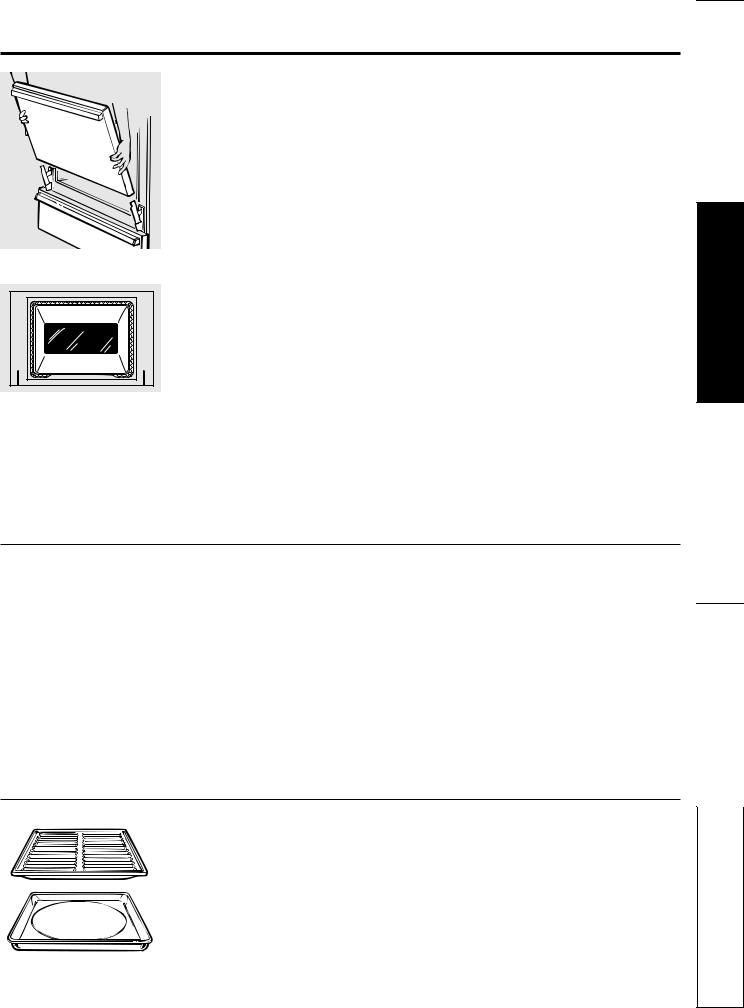
www.GEAppliances.com
Lift the door straight up and off the hinges.
The gasket is designed with a gap at the bottom to allow for proper air circulation.
Lift-Off Oven Door
The oven door is removable, but it is heavy. You may need help removing and replacing the door.
To remove the door, open it a few inches to the special stop position that will hold the door open. Grasp firmly on each side and lift the door straight up and off the hinges.
NOTE: Be careful not to place hands between the hinge and the oven door frame as the hinge could snap back and pinch fingers.
To replace the door, make sure the hinges are in the special stop position. Position the slots in the bottom of the door squarely over the hinges. Then lower the door slowly and evenly over both hinges at the same time. If the hinges snap back against the oven frame, pull them back out.
To clean the inside of the door:
■Do not allow excess water to run into any holes or slots in the door.
To clean the outside of the door:
■Use soap and water to thoroughly clean the top, sides and front of the oven door. Rinse well. You may also use a glass cleaner to clean the glass on the outside of the door.
■Spillage of marinades, fruit juices, tomato sauces and basting materials containing acids may cause discoloration and should be wiped up immediately. When the surface is cool, clean and rinse.
■Do not use oven cleaners, cleansing powders or harsh abrasives on the outside of the door.
Do not rub or clean the door gasket— ■ The area outside the gasket can be
it has an extremely low resistance cleaned with a soap-filled steel wool or to abrasion.
plastic pad.
If you notice the gasket becoming worn, frayed or damaged in any way or if it has become displaced on the door, you should have it replaced.
Oven Bottom
The oven bottom has a porcelain enamel finish. To make cleaning easier, protect the oven bottom from excessive spillovers by placing a cookie sheet on the shelf below the shelf you are cooking on. This is particularly important when baking a fruit pie or other foods with a high acid content. Hot fruit fillings or other foods that are highly acidic (such as tomatoes, sauerkraut and sauces with vinegar or lemon juice) may cause pitting and damage to the porcelain enamel surface and should be wiped up immediately.
We don’t recommend using aluminum foil on the oven bottom. It can affect air flow if the holes are blocked and it can concentrate heat at the bottom of the oven, resulting in poor baking performance.
To clean up spillovers, use soap and water, an abrasive cleaner or soap-filled steel-wool pad. Rinse well to remove any soap.
|
Grid |
Broiler Pan and Grid |
|
|
|
|
After broiling, remove the broiler pan from |
|
|
|
the oven. Remove the grid from the pan. |
|
|
|
Carefully pour out grease from the pan |
|
|
|
into a proper container. Wash and rinse |
|
|
|
|
|
|
|
the broiler pan and grid in hot water |
|
|
|
|
|
|
|
with a soap-filled or plastic scouring pad. |
|
|
|
|
|
|
|
If food has burned on, sprinkle the grid |
|
Pan |
with detergent while hot and cover with |
|
|
|
|
wet paper towels or a dishcloth. Soaking |
|
|
|
the pan will remove burned-on foods. |
The broiler pan and grid may be cleaned with a commercial oven cleaner.
Both the broiler pan and grid can also be cleaned in a dishwasher.
Do not store a soiled broiler pan and grid anywhere in the range.
 CAUTION: Do not clean the broiler
CAUTION: Do not clean the broiler
pan or grid in a self-cleaning oven.
23
Support Consumer Tips Troubleshooting Instructions Installation Instructions Operating Instructions Safety
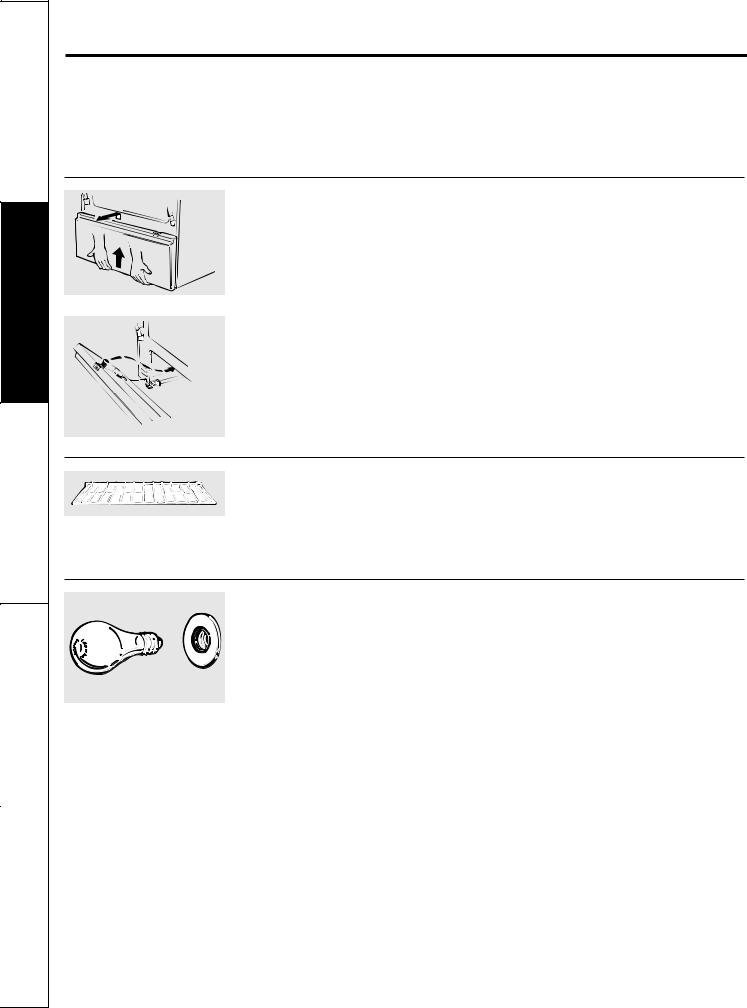
Consumer Support Troubleshooting Tips Installation Instructions Operating Instructions Safety Instructions
Care and cleaning of the range.
Broiler Compartment (on some models)
When the broiler compartment is cool, remove the grid and pan. Clean the broiler compartment with hot soapy water. Rinse thoroughly with a damp cloth and dry.
Removable Kick Panel (on some models)
The kick panel may be removed for cleaning under the range.
To remove:
Lift up the bottom of the panel slightly to disengage the panel from the tabs at the base of the range. Pull the bottom of the panel forward until the spring clips are released at the top of the panel.
To replace:
Insert the two slots at the bottom of the panel onto the two tabs at the base of the range, and push the top of the panel forward to engage the spring clips.
Oven Shelves
Clean the shelves with an abrasive cleanser or scouring pad. After cleaning, rinse the shelves with clean water and dry with a clean cloth.
Oven Light Replacement
 CAUTION: Before replacing your oven light bulb, disconnect the electrical power to the range at the main fuse or circuit breaker panel. Do not touch a hot light bulb with wet hands or a wet cloth. Be sure to let the bulb cool completely and use a dry cloth.
CAUTION: Before replacing your oven light bulb, disconnect the electrical power to the range at the main fuse or circuit breaker panel. Do not touch a hot light bulb with wet hands or a wet cloth. Be sure to let the bulb cool completely and use a dry cloth.
The light bulb is located in the upper left corner (may vary) of the oven. Replace the bulb with a 40-watt appliance bulb only.
24
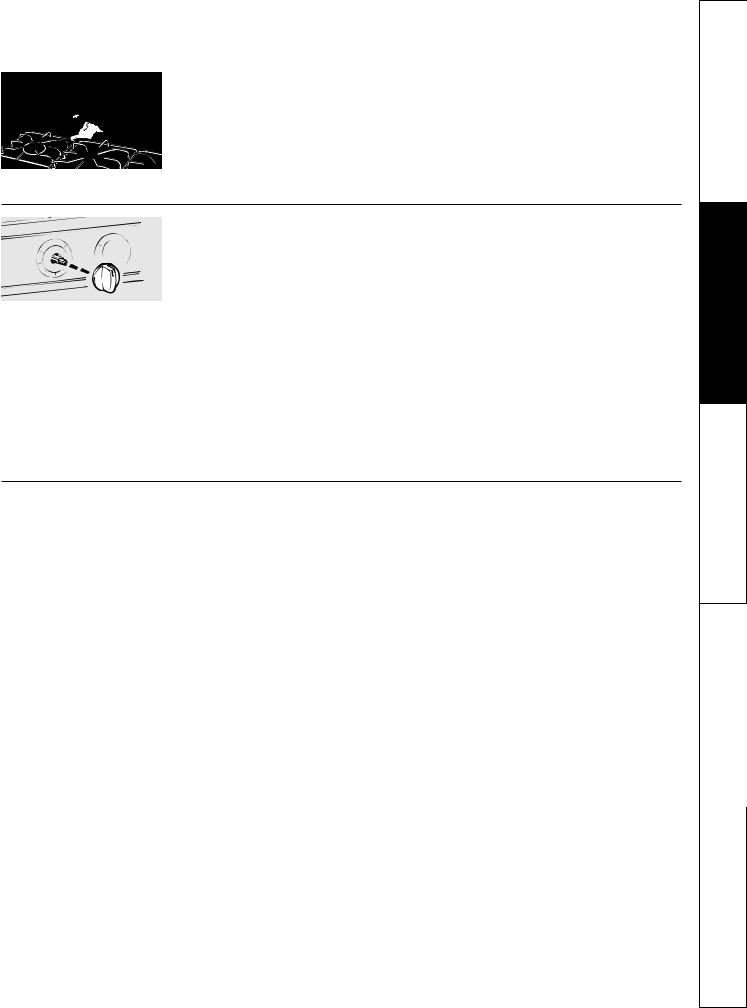
|
|
|
www.GEAppliances.com |
|
|
|
|
|
|
Oven Air Vents |
|
|
|
|
|
|
|
Never block the vents (air openings) of the |
Air openings are located at the rear of |
|
|
range. They provide the air inlet and outlet |
the cooktop, at the top and bottom of the |
|
|
that are necessary for the range to operate |
oven door, and at the bottom of the range, |
|
|
properly with correct combustion. |
under kick panel or broiler compartment |
|
|
|
(depending on the model). |
Vent appearance and location vary.
Lower Control Panel (Front Manifold Panel) and Knobs
Pull the knob straight off the stem.
It’s a good idea to wipe the control panel after each use of the oven. Use a damp cloth to clean or rinse. For cleaning, use mild soap and water or a 50/50 solution of vinegar and water. For rinsing, use clean water. Polish dry with a soft cloth.
Do not use abrasive cleansers, strong liquid cleaners, plastic scouring pads or oven cleaners on the control panel—they will damage the finish.
Do not bend knobs by pulling them up or down or by hanging a towel or other such loads. This can damage the gas valve shaft.
The control knobs may be removed for easier cleaning. To remove a knob, pull it straight off the stem. If knob is difficult to remove, place a towel or dishcloth between the knob and control panel and pull gently. Wash the knobs in soap and water or a vinegar and hot water solution.
Metal parts can be cleaned with soap and water. Do not use steel wool, abrasives, ammonia, acids or commercial oven cleaners. Dry with a soft cloth.
Porcelain Oven Interior
With proper care, the porcelain enamel interior will retain its attractive finish for many years.
Soap and water will normally do the job. Heavy spattering or spillovers may require cleaning with a mild abrasive cleanser. Soap-filled scouring pads may also be used. Do not allow food spills with a high sugar or acid content (such as tomatoes, sauerkraut, fruit juices or pie filling) to remain on the surface. They may cause dull spots even after cleaning.
Household ammonia may make the cleaning job easier. Place 1/2 cup ammonia in a shallow glass pan and leave in a cold oven overnight. The ammonia fumes will help loosen the burned-on grease and food.
When necessary, you may use a commercial oven cleaner. Follow the package directions.
Cautions about using spray-on oven cleaners:
■Be careful where the oven cleaner is sprayed.
■Do not spray oven cleaner on the electrical controls and switches (on some models) because it could cause a short circuit and result in sparking or fire.
■Do not allow a film from the cleaner to remain on the temperature sensing bulb—it could cause the oven to heat improperly. (The bulb is located at the rear of the oven.) Carefully wipe the bulb clean after each oven cleaning, being careful not to move the bulb as a change in its position could affect how the oven bakes.
■Do not spray any oven cleaner on the outside oven door, handles or any exterior surface of the oven, cabinet or painted surfaces. The cleaner can damage these surfaces.
25
Support Consumer Tips Troubleshooting Instructions Installation Instructions Operating Instructions Safety
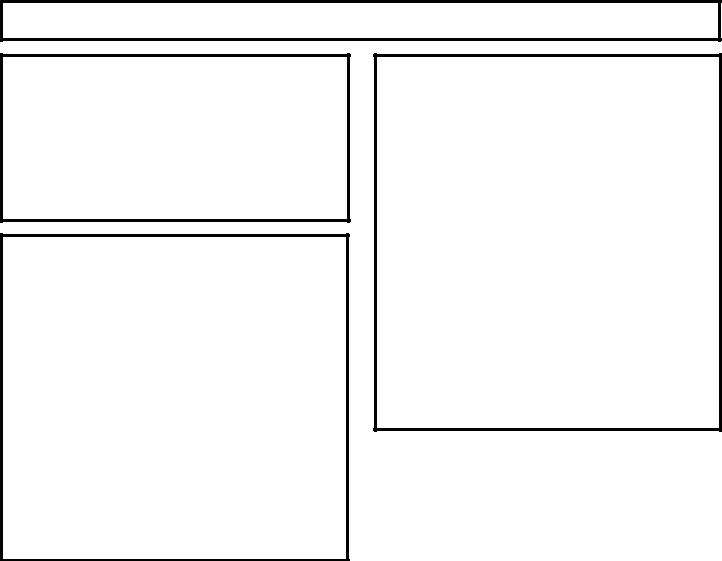
Installation |
Range |
Instructions |
|
If you have questions, call 800.GE.CARES or visit our Website at: www.GEAppliances.com
In the Commonwealth of
Massachusetts:
•This product must be installed by a licensed plumber or gas fitter.
•When using ball-type gas shut-off valves, they shall be the T-handle type.
•A flexible gas connector, when used, must not exceed 3 feet.
BEFORE YOU BEGIN
Read these instructions completely and carefully.
Installation of this range must conform with local codes, or in the absence of local codes, with the National Fuel Gas Code, ANSI Z223.1/NFPA.54, latest edition. This range has been design-certified by CSA International according to ANSI Z21.1, latest edition and Canadian Gas Association according to CAN/CGA-1.1 latest edition.
As with any appliance using gas and generating heat, there are certain safety precautions you should follow. You will find these precautions in the Important Safety Information section in the front of this manual. Read them carefully.
• IMPORTANT – Save these
instructions for local electrical inspector’s use.
• IMPORTANT – Observe all governing codes and ordinances.
•Note to Installer – Be sure to leave these instructions with the Consumer.
•Note to Consumer – Keep these instructions for future reference.
•Note – This appliance must be properly grounded.
•Servicer – The electrical diagram is in an envelope attached to the back of the range.
•Skill level – Installation of this appliance requires basic mechanical skills.
•Proper installation is the responsibility of the installer.
•Product failure due to improper installation is not covered under the Warranty.
26

Installation Instructions
FOR YOUR SAFETY
Do not store or use combustible materials, gasoline or other flammable vapors and liquids in the vicinity of this or any other appliance.
If you smell gas:
 Open windows.
Open windows.
 Don’t touch electrical switches.
Don’t touch electrical switches.
 Extinguish any open flame.
Extinguish any open flame.  Immediately call your gas supplier.
Immediately call your gas supplier.
TOOLS YOU WILL NEED
Phillips screwdriver |
|
|
Flat-blade screwdriver |
Open-end or |
|
adjustable wrench |
||
|
||
Pencil and ruler |
Level |
|
|
|
|
|
Drill, awl or nail |
Pipe wrenches (2) |
|
|
(one for backup) |
|
|
PART INCLUDED
Anti-tip bracket kit
MATERIALS YOU MAY NEED
•Gas line shut-off valve
•Pipe joint sealant or UL-approved pipe thread tape with Teflon* that resists action of natural and LP gases
•Flexible metal appliance connector (1/2 ″ I.D.) A 5-foot length is recommended for ease of installation but other lengths are acceptable. Never use an old connector when installing a new range.
•Flare union adapter for connection to gas supply line (3/4 ″ or 1/2 ″ NPT x 1/2 ″ I.D.)
•Flare union adapter for connection to pressure regulator on range (1/2 ″ NPT x 1/2 ″ I.D.)
•Liquid leak detector or soapy water.
•Lag bolt or 1/2″ O.D. sleeve anchor (for concrete floors only).
*Teflon: Registered trademark of DuPont
27
